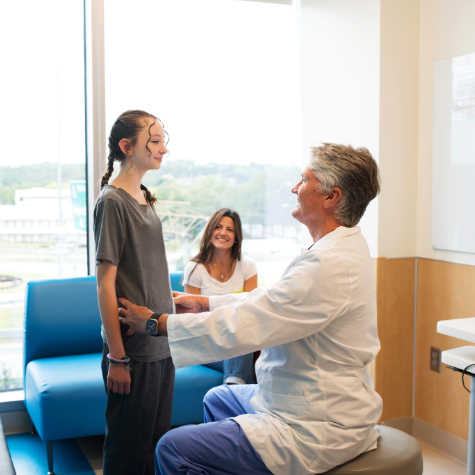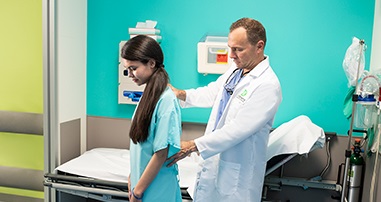Spine Fusion Surgery
Curves of the spine due to conditions like scoliosis, kyphosis, spondylolisthesis and some spinal injuries can sometimes be treated with bracing and physical therapy. Not all kids and teens with a spine condition will need surgery, which is why it's so important to see a pediatric spine specialist who is specially trained to treat scoliosis and other spine conditions in kids and teens who are still growing. While the orthotists and physical therapists at Children's Healthcare of Atlanta are specially trained to treat these conditions without surgery, sometimes surgery is necessary based on a child's:
- Age
- Spinal curve
- Remaining growth
When is spine surgery necessary?
In some cases, severe spinal curves can become painful and may cause changes in heart or lung function, or damage spinal cord function if a surgery is not performed. Spine surgery can help stabilize these curves, which prevents them from getting worse and can help improve spinal alignment.
Which spine surgery will my child need?
The most common type of spine surgery to correct scoliosis is called a spinal fusion, but your child’s pediatric spine specialist may recommend a different type of surgery based on your child’s:
- Unique condition
- Spinal Curve
- Health history
- Previous treatments
- Age
- Remaining growth
If a spinal fusion operation is needed, our spine surgeons have cutting-edge technology, instruments and techniques available to speed up healing and help reduce complications.
A pediatric spinal fusion is sometimes referred to as the “gold standard” for spinal curve corrective surgery. This surgery involves implanting metal rods that fuse vertebrae, or bones, in the spine together. The rods, along with a bone graft, are used to realign the spine to minimize the curve as much as possible and permanently keep the spine in its new, balanced position. This is a common scoliosis surgery for for kids and teens that have a worsening curve, despite noninvasive spine treatments. It may be recommended for children, teens or young adults with curves greater than 45 degrees.
Types of spinal fusion
There are three approaches to spinal fusion surgery:
- Posterior spine fusion: Performed on the back of the spine through an incision in your child’s back. This is the most common.
- Anterior spine fusion: Performed on the front part of the spine through an incision in your child’s side.
- Anterior-posterior: Performed on the front and back part of the spine through two incisions. This technique is only used in special circumstances.
How does spinal fusion surgery work?
All three types of spinal fusion surgical methods use bone, metal rods and screws to fuse the backbones together. The metal rods and screws help keep the bones in the right place and hold them straight. A bone graft acts as a bridge and grows into the spaces between the backbones, fusing them together.
The bone graft can come from:
- A bone bank from someone who donated their bone—this is called an allograft.
- A piece of bone from your child’s own body—this is called an autograft. While not as common, this technique uses a piece of bone usually taken from the spine during the spinal fusion surgery, but is sometimes taken from the hip.
Will it correct my child’s curve?
The main goal of a spinal fusion is to fuse the spine and keep the spinal curve from getting worse, but it may not completely correct the curve. In some instances, flexible curves that are fairly small can be almost completely corrected. In other cases, it can be dangerous to achieve complete correction. Your child’s doctor will talk to you about your child’s specific surgery goals.
Preparing for Spinal Fusion Surgery
-
Spine Fusion Surgery for Scoliosis
Watch an animation of how spinal fusion surgery works, including what happens during surgery and what recovery is like.
Scoliosis surgery is a big deal—for your child and for your family. So you want them in the hands of the best pediatric orthopedic surgeons for scoliosis. Here are some things to consider as you select a surgeon for your child.
Our team knows how to keep kids and teens safe during spine surgery.
Our No. 1 focus is patient safety and quality. Our spine surgeons are leaders in optimizing pediatric spinal fusion safety best practices across the country, as we perform more spine surgeries than any other pediatric hospital in the U.S.*
Our operating room team of surgeons, pediatric anesthesiologists and nurses follow special procedures that help keep patients safe, including:
- Special neuromonitoring to closely observe the spinal cord and help prevent neurological injuries.
- Medication and safety measures to minimize blood loss.
- Robust infection prevention program that helps us avoid surgical site infections.
We have also earned Level 1 status from the American College of Surgeons for Children’s Surgery Verification—its highest designation. No other hospitals in Georgia have achieved this level. So when your child needs surgery, you can take comfort in knowing that we meet the highest distinction.
We guarantee your child will have a pediatric anesthesiologist, specially trained to treat kids and teens.
A pediatric anesthesiologist will be with your child throughout their entire spine surgery to help monitor their condition while the surgeon works, and as they wake up and recover. Our anesthesiologists are specially trained to work with children and help provide a safe environment for kids, from infants with the most difficult issues to teens.
Caring for children at every stage is our No. 1 concern.
Our spinal surgery team guides each family step by step through the process. Before spinal fusion surgery, our team meets with spine patients and their families to talk through the surgery plan and concerns. The team will provide families with a spine surgery handbook and other resources to help prepare your family. Our dedicated spine surgery liaison can help your family with any questions before, during and after care, and serve as a single point of contact for your child and their primary care provider. Our goal is to help reduce anxiety and make sure all questions are answered before a child’s surgery.
The spine surgery liaison will help coordinate care by:
- Providing information about lodging and key contacts for those who live outside metro Atlanta.
- Arranging travel accommodations to Atlanta and transportation while in Atlanta.
- Helping families navigate our hospitals and escorting them as needed.
- Assisting with the hospital intake process and clinic visits.
- Writing treatment plans for your child’s referring provider.
- Assisting in arranging the use of durable medical equipment after your child or teen is released from the hospital.
- Coordinating interpretation services.
- Coordinating financial planning with insurance companies.
- Following up with you after your child’s procedure or visit.
- Communicating with and coordinating requests for your child’s referring provider.
Contact concierge services at 404-255-1933.

Meet Our Orthopedic Spine Surgeons
Your child’s spine will be in expert hands with our pediatric-specialized spine surgeons. When you come to Children’s, you can rest assured that more parents trust us for their child’s spine surgery than any other children’s hospital in the country*.
find a specialist*Pediatric Health Information System (2024), as prepared by the Children’s Hospital Association. This report compares clinical data annually for more than 52 pediatric hospitals in the U.S.
Contact Us 404-255-1933



